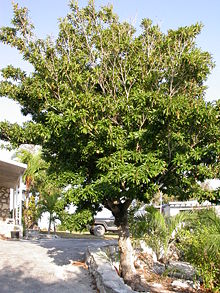සැපදිල්ලා
| සැපතිල්ලා | |
|---|---|

| |
| සැපතිල්ලා ගසක් | |
| විද්යාත්මක වර්ගීකරණය | |
| රාජධානිය: | ශාක |
| (unranked): | Angiosperms |
| (unranked): | Eudicots |
| (unranked): | Asterids |
| ගෝත්රය: | Ericales |
| කුලය: | Sapotaceae |
| ගණය: | 'Manilkara' |
| විශේෂය: | M. zapota |
| ද්වීපද නාමය | |
| Manilkara zapota (L.) P. Royen | |
සැපතිල්ලා (මැන්රිලාරා පොප්ටා) යනු දිගු කාලයක් ජීවත් වූ සදාහරිත ශාකයකි. මෙක්සිකෝවේ ඉන්දියාවේ විශාල වශයෙන් වගා කෙරෙන අතර ස්පාඤ්ඤ යටත්විජිත සමයේදී පිලිපීනය වෙත හඳුන්වා දෙන ලදි.
Sapodilla (Manilkara zapota) is a long-lived, evergreen tree native to southern Mexico and Central America.[1] It is grown in huge quantities in India, Mexico and was introduced to the Philippines during Spanish colonisation.
විස්තරය(Description) සංස්කරණය
සැපතිල්ලා 3-4 මීටර් උසයි. සුළඟින් ප්රතිරෝධී වන අතර පොත්තේ සුදු පැහැති, ගම්මිරිස් යන චිකන් ලෙස පොහොසත් වේ. විසිතුරු කොළ මධ්යම හරිත හා ග්ලැසියි. ඔවුන් විකල්ප ආවරණය, ඉලිප්පීම් සඳහා සෙමී 7-15 සෙ.මී. දිග, සම්පූර්ණ ආන්තිකය සමග. සුදු මල් නොකැඩී හා සීනුව වැනි හිසකෙස් හාරන ලද සොරොල්ලක් සමඟ. මෙම පළතුරු විෂ්කම්භය 4-8 සෙ.මී. විශාල, ඉලිප්සායිඩ බෙරී, සුමට මුහුණැති අර්තාපල් හා 2-5 බීජ අඩංගු වේ. ඇතුළත, එහි මස් කහ පාට කහ සිට පෘෂ්ඨීය දුඹුරු වර්ණයෙන් යුක්ත වේ. බීජ අඳුරු වී ඇති අතර, උන්ගේ ගෙලෙහි අල්ලා ගත හැකි එක් කකුලක කොක්කක් සමග බෝංචි වැනි සමාන වේ. රසය ඉතා රසවත් හා රසවත් වන අතර එය රසවත් රසයක් ලෙස විස්තර කළ හැකිය. නොගැඹුරු පළතුරු ස්පන්දනයට දැඩි හා සන්හීනින අධික ප්රමාණයක් අඩංගු වේ. ටැන්ින්ට ආලේපිත ගුණ ඇති අතර මුඛය වියළීම. සැපතිල්ලා ගස් වසරකට දෙවරක් ඵල දරයි. නමුත් මල් හට වසරක් ගත විය හැකිය. පළතුරු උරාබෙන අධික රබර් කිරි අඩංගු වන අතර එය තෝරා නොගත්තද ඉදිමීම සිදු නොවේ. සමහරු වටා ඇති අතර ඇතැම් ඒවා දිදුලන කෙළවරවල් සහිත වේ.
Sapodilla grows to 3-4 m tall. It is wind-resistant and the bark is rich in a white, gummy latex called chicle. The ornamental leaves are medium green and glossy. They are alternate, elliptic to ovate, 7-15 cm long, with an entire margin. The white flowers are inconspicuous and bell-like, with a six-lobed corolla.
The fruit is a large ellipsoid berry, 4-8 cm in diameter, very much resembling a smooth-skinned potato and containing 2-5 seeds. Inside, its flesh ranges from a pale yellow to an earthy brown color with a grainy texture akin to that of a well-ripened pear. The seeds are black and resemble beans, with a hook at one end that can catch in the throat if swallowed.
The flavor is exceptionally sweet and very tasty, with what can be described as a malty flavor. The unripe fruit is hard to the touch and contains high amounts of saponin, which has astringent properties similar to tannin, drying out the mouth.
The sapodilla trees yield fruit twice a year, though flowering may continue year round. The fruit has a high latex content and does not ripen until picked. Some are round and some are oval with pointed ends.
වෙනත් නම්(Other Names) සංස්කරණය
සැපතිල්ලා, චීනයේ ("චිකිකෝ" හෝ "චිකු", "චිකෝ") සහ ඉන්දියාවේ sapota ලෙස හඳුන්වයි. නැගෙනහිර ඉන්දියාවේ සෝෆෙඩා සහ බංග්ලාදේශය, ඉන්දුනීසියාව, හොන්ග් xiêm ("සිමාසියා පර්සිමොන්") හෝ xa pô chê තායිලන්තය, කාම්බෝජය, වියට්නාම, කම්බෝඩියාව, ග්වාන සපාතිල්ලා, කොලොම්බියාව, නිකරගුවාව, එල් සැල්වඩෝර්, ඩොමිනිකානු ජනරජය සහ වෙනිසියුලාව, කියුබාවේ, පුවර්ටෝ රිකෝ සහ ඩොමිනිකානු ජනරජයේ ඩිලීසියානු ජනරජයේ ඩිලීසෝ බහමාස්, කැරිබියානු සෙසු නසීබෙරි, බ්රසීලයේ sapoti සහ හවායි හි දකුනු කැලිෆෝනියාවේ හා දකුණු ෆ්ලොරිඩා හි චිකෝ සපෝටේය. කෙලන්තානෙස් මැලේහි, පලතුරු "සම්මත සිලෝ නිලෝ" යනුවෙන් හඳුන්වනු ලැබේ. එය සම්මත මැලේ "ciku" වලට වඩා මුල් නාමයට සමීපව පිහිටා තිබේ. චීන භාෂාවෙන්, මෙම නම දළ වශයෙන් "ගින්සෙන් ගෙඩිය" ට පරිවර්තනය කරයි. මෙය අනිත්ය පලතුරක් වන pepino සඳහා භාවිතා කරන නමකි.
Sapodilla is known as chikoo ("चिक्कू" or "chiku," "चीकू,") and sapota in India, sofeda in eastern India and Bangladesh, sawo in ඉන්දුනීසියාව, hồng xiêm (lit. "Siamese persimmon") or xa pô chê in Vietnam, lamoot (ละมุด) in Thailand and Cambodia, sapodilla in Guyana sapathilla or rata-mi in Sri Lanka, níspero in Colombia, Nicaragua, El Salvador, Dominican Republic and Venezuela, nípero in Cuba, Puerto Rico and Dominican Republic, dilly in The Bahamas, naseberry in the rest of the Caribbean, sapoti in Brazil, and chico sapote in Hawaii, southern California and southern Florida.[2][3] In Kelantanese Malay, the fruit is called "sawo nilo" which is closer to the original name than the standard Malay "ciku". In Chinese, the name translates roughly to "ginseng fruit" (人參果), though this is also the name used for the pepino, an unrelated fruit.
ශ්රී ලංකාව සංස්කරණය
තෙත් හා මැද රට කලාපයේ වගාකළ හැකි පලතුරකි.
External links සංස්කරණය
- CRFG Publications: Sapodilla සංරක්ෂණය කළ පිටපත 2008-12-06 at the Wayback Machine
- Sapodilla
References සංස්කරණය
- ↑ "Manilkara zapota". Germplasm Resources Information Network. United States Department of Agriculture. සම්ප්රවේශය 2009-01-29.
- ↑ "California Rare Fruit Growers, Sapodilla Fruit Facts[permanent dead link] Retrieved on 2009/03/26
- ↑ "College of Tropical Agriculture and Human Resources, Ten Tropical Fruits of Potential Value for Crop Diversification in Hawaii Retrieved on 2009/03/26